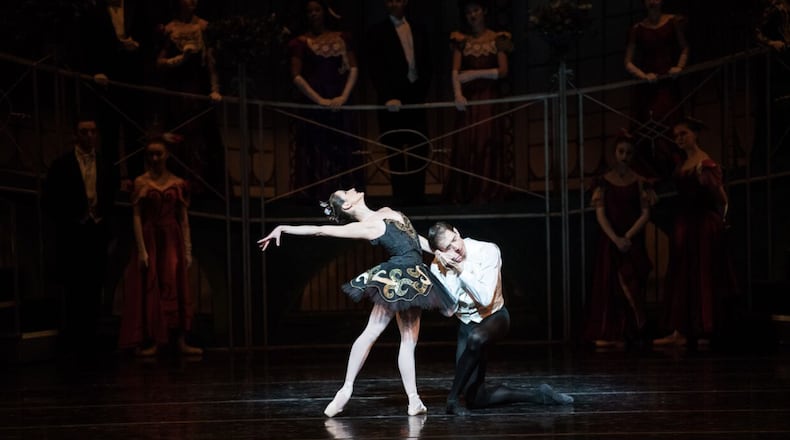He should know. Webre is well known for the dramatic version of “Swan Lake’' he originally created for the American Repertory Ballet in 1996. First performed by Dayton Ballet in 1998 and more recently in 2018, it will be on stage at the Schuster Center Feb. 16-18.
Webre is currently the artistic director of the Hong Kong Ballet and was formerly director of The Washington Ballet. He’s had a Dayton connection for decades. In addition to working on “Swan Lake,” he has staged a number of other ballets for the Dayton company — ”Romeo and Juliet,” “Peter Pan” and repertory pieces.
A love story
“Swan Lake” centers around the character of Prince Siegfried who encounters a flock of swans on a hunting trip and falls in love with Odette, the Swan Queen. She has been cursed by the evil sorcerer, Baron von Rothbart, and can only take human form between midnight and daybreak. Only true love can break the spell.
“Unlike the traditional staging, which is generally set in Europe in medieval times, I have set the work in New York high society in 1905, during an era when educated society began a fascination with psychology and the mind,” said Webre. “Siegfried is loosely based on John Jacob Astor, who has a complex relationship with his mother and her love. Siegfried experiences feverish dreams of a white swan and a black swan which ultimately leads to his undoing.”
Webre believes there is nothing more challenging for dancers in the classical canon than “Swan Lake.”
“There is the purity of classical line for the corps, as well as a feeling of cohesiveness when they dance as a group,” he said. “For the ballerina, the rigors of both the White Swan and the Black Swan are unrivaled in terms of artistry, technique and sheer stamina.”
Webre, known for his story ballets, comes from a generation of choreographers raised on abstraction.
“Balanchine and Cunningham defined modernity in dance and serious choreographers didn’t really make stories then,” he said. " But eventually I organically discovered that I am, by nature, a storyteller.”
Since staging “Swan Lake.” he has gone on to create between 10 and 12 full-length story ballets.
“It’s somehow in my DNA,” he said.
Webre calls the language of dance metaphorical. “
Even when telling a story, ballet succeeds best in describing human emotion and distilling aspects of the human condition rather than providing plot point,” he said. “So telling a story in a way which is simple but moving is always the goal. Seeing ‘Swan Lake’ in one’s life should always be on one’s bucket list.”
Becoming a swan
Dayton native Claire Bergman is in her seventh season with Dayton Ballet and will portray the White Swan in the upcoming production. She labels the role both extremely challenging and rewarding. “It is hard to portray a swan with the arms and specific head,” she said. ”It’s an emotional part and one that I really love dancing.”
Bergman, who has danced a number of other Webre ballets, says his choreography is definitely unique.
“They are each fast-paced and intricate in their own way,” she said. “I danced this version of ‘Swan Lake’ with Dayton Ballet in 2018 and I had many roles. The corps of this ballet is the most challenging as you are in every single part, constantly changing costumes and on stage throughout.”
She’s always loved to dance and started dancing at the age of 3.
“My sister was a dancer and I followed in her footsteps. I trained here in Dayton with Barbara Pontecorvo and then attended University of Cincinnati.”
Bergman feels dance is a way to express herself.
“I’ve always loved music and trying to become the music with my body,” she said. “Becoming a mom has only increased my love for this art form. It has made me stronger in many ways and makes me enjoy every moment that I get to dance.”
Belle Urben, who is in her first season with the Dayton Ballet, will portray the Black Swan. She describes the role as technically challenging, requiring a lot of stamina.
“After most of my dancing when I’m very tired already, I have 32 consecutive turns,” she said. “You also need to keep the characterization of the Black Swan while you are this tired, which is a challenge.”
Urben, who also started dancing at age three, says dance makes her feel her strong and confident.
“Especially with a role like this that is very difficult, it is very fulfilling to perform after all the hard work you put into it.,” she said.
It’s the third time she has performed professionally in “Swan Lake,” and it was the first full-length ballet she performed in school.
“I’m very excited to be performing it again, especially as Odile,” she said. “Black Swan has always been my favorite part of the ballet. The music and choreography in this ballet are both so beautiful. I hope fans of the Philharmonic and the ballet will really enjoy the show.”
About the music
Webre hasn’t made it easy when it comes to the music as well. Dayton Philharmonic Orchestra conductor Neal Gittleman said the choreographer has a “somewhat idiosyncratic route through Tchaikovsky’s score.” He says that’s not unusual for choreographers dealing with the long Tchaikovsky ballets — both “Swan Lake” and “Sleeping Beauty.”
Gittleman said while audiences will hear all of the familiar musical highlights of the ballet, in some cases their placement in the chronology have been shuffled a bit.
“Septime structures the ballet in two acts instead of Tchaikovsky’s four. Musically, the “white acts (the scenes by the lake) follow Tchaikovsky’s roadmap pretty faithfully.”
He said the scenes that take place in the real world are where most of the shuffles take place. In 2018, when Dayton Ballet performed Webre’s “Swan Lake” for the first time with live music, Gittleman admits it took a lot of work by orchestra librarian Eric Knorr to get all the music arranged in Webre’s desired order.
“Fortunately, that work’s done and doesn’t have to be repeated,” Gittleman said. “And I’ve already told Dayton Ballet’s new artistic director Brandon Ragland that when he wants to create his ‘Swan Lake’ we have all of Tchaikovsky’s music on-hand, and he can create his own path through Tchaikovsky’s score, which is fabulous from first note to last.”
The first time Gittleman was involved with “Swan Lake” he dubbed the original story “kind of goofy.” But he added that Septime Webre’s scenario for the non-swan scenes had a very compelling physiology to it.
“The emotional power of the music really animates and reinforces that,” he said at that time. “The set pieces for dance are all perfect for the choreography and the dramatic and narrative passages, such as the final scene, are absolutely masterful. Seeing all those swans at once is absolutely mesmerizingly beautiful.”
How to go
What: “Swan Lake,” by the Dayton Ballet, choreographed by Septime Webre
When: 7:30 p.m. on Friday, Feb. 16 and Saturday, Feb. 17 and 2:30 p.m. on Sunday, Feb. 18
Where: Benjamin and Marian Schuster Center, 1 W. 2nd St., Dayton
Tickets: $13.50-$88.50. Call the Dayton Live Ticket Office at (937) 228-3630
Related programming
A live pre-concert talk, “Take Note,” is given from the stage in the Schuster Center beginning one hour before the performance. Speakers include conductor Neal Gittleman and Dayton Ballet’s artistic director Brandon Ragland. This event will take place on the third-floor balcony lobby.
About the Author






